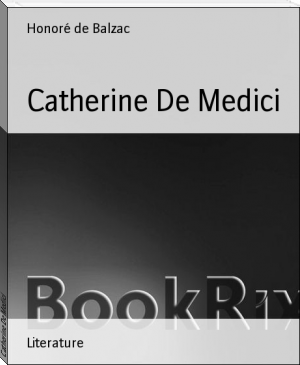Catherine De Medici, Honoré de Balzac [best short novels of all time TXT] 📗

- Author: Honoré de Balzac
Book online «Catherine De Medici, Honoré de Balzac [best short novels of all time TXT] 📗». Author Honoré de Balzac
"The king called an assembly at Lyon of all the princes of his
blood, all the knights of his order, and other great personages of
the kingdom; also the legal and papal nuncio, the cardinals who
were at his court, together with the ambassadors of England,
Scotland, Portugal, Venice, Ferrara, and others; also all the
princes and noble strangers, both Italian and German, who were
then residing at his court in great numbers. These all being
assembled, he caused to be read to them, in presence of each
other, from beginning to end, the trial of the unhappy man who
poisoned Monseigneur the late dauphin,--with all the
interrogatories, confessions, confrontings, and other ceremonies
usual in criminal trials; he, the king, not being willing that the
sentence should be executed until all present had given their
opinion on this heinous and miserable case."
The fidelity, devotion, and cautious skill of the Comte de Montecuculi may seem extraordinary in our time, when all the world, even ministers of State, tell everything about the least little event with which they have to do; but in those days princes could find devoted servants, or knew how to choose them. Monarchical Moreys existed because in those days there was _faith_. Never ask devotion of _self-interest_, because such interest may change; but expect all from sentiments, religious faith, monarchical faith, patriotic faith. Those three beliefs produced such men as the Berthereaus of Geneva, the Sydneys and Straffords of England, the murderers of Thomas a Becket, the Jacques Coeurs, the Jeanne d'Arcs, the Richelieus, Dantons, Bonchamps, Talmonts, and also the Clements, Chabots, and others.
The dauphin was poisoned in the same manner, and possibly by the same drug which afterwards served MADAME under Louis XIV. Pope Clement VII. had been dead two years; Duke Alessandro, plunged in debauchery, seemed to have no interest in the elevation of the Duc d'Orleans; Catherine, then seventeen, and full of admiration for her father-in-law, was with him at the time; Charles V. alone appeared to have an interest in his death, for Francois I. was negotiating for his son an alliance which would assuredly have aggrandized France. The count's confession was therefore very skilfully based on the passions and politics of the moment; Charles V. was then flying from France, leaving his armies buried in Provence with his happiness, his reputation, and his hopes of dominion. It is to be remarked that if torture had forced admissions from an innocent man, Francois I. gave Montecuculi full liberty to speak in presence of an imposing assembly, and before persons in whose eyes innocence had some chance to triumph. The king, who wanted the truth, sought it in good faith.
In spite of her now brilliant future, Catherine's situation at court was not changed by the death of the dauphin. Her barrenness gave reason to fear a divorce in case her husband should ascend the throne. The dauphin was under the spell of Diane de Poitiers, who assumed to rival Madame d'Etampes, the king's mistress. Catherine redoubled in care and cajolery of her father-in-law, being well aware that her sole support was in him. The first ten years of Catherine's married life were years of ever-renewed grief, caused by the failure, one by one, of her hopes of pregnancy, and the vexations of her rivalry with Diane. Imagine what must have been the life of a young princess, watched by a jealous mistress who was supported by a powerful party,--the Catholic party,--and by the two powerful alliances Diane had made in marrying one daughter to Robert de la Mark, Duc de Bouillon, Prince of Sedan, and the other to Claude de Lorraine, Duc d'Aumale.
Catherine, helpless between the party of Madame d'Etampes and the party of the Senechale (such was Diane's title during the reign of Francois I.), which divided the court and politics into factions for these mortal enemies, endeavored to make herself the friend of both Diane de Poitiers and Madame d'Etampes. She, who was destined to become so great a queen, played the part of a servant. Thus she served her apprenticeship in that double-faced policy which was ever the secret motor of her life. Later, the _queen_ was to stand between Catholics and Calvinists, just as the _woman_ had stood for ten years between Madame d'Etampes and Madame de Poitiers. She studied the contradictions of French politics; she saw Francois I. sustaining Calvin and the Lutherans in order to embarrass Charles V., and then, after secretly and patiently protecting the Reformation in Germany, and tolerating the residence of Calvin at the court of Navarre, he suddenly turned against it with excessive rigor. Catherine beheld on the one hand the court, and the women of the court, playing with the fire of heresy, and on the other, Diane at the head of the Catholic party with the Guises, solely because the Duchesse d'Etampes supported Calvin and the Protestants.
Such was the political education of this queen, who saw in the cabinet of the king of France the same errors committed as in the house of the Medici. The dauphin opposed his father in everything; he was a bad son. He forgot the cruel but most vital maxim of royalty, namely, that thrones need solidarity; and that a son who creates opposition during the lifetime of his father must follow that father's policy when he mounts the throne. Spinosa, who was as great a statesman as he was a philosopher, said--in the case of one king succeeding another by insurrection or crime,--
"If the new king desires to secure the safety of his throne and of
his own life he must show such ardor in avenging the death of his
predecessor that no one shall feel a desire to commit the same
crime. But to avenge it _worthily_ it is not enough to shed the
blood of his subjects, he must approve the axioms of the king he
replaces, and take the same course in governing."
It was the application of this maxim which gave Florence to the Medici. Cosmo I. caused to be assassinated at Venice, after eleven years' sway, the Florentine Brutus, and, as we have already said, persecuted the Strozzi. It was forgetfulness of this maxim which ruined Louis XVI. That king was false to every principle of royal government when he re-established the parliaments suppressed by his grandfather. Louis XV. saw the matter clearly. The parliaments, and notably that of Paris, counted for fully half in the troubles which necessitated the convocation of the States-general. The fault of Louis XV. was, that in breaking down that barrier which separated the throne from the people he did not erect a stronger; in other words, that he did not substitute for parliament a strong constitution of the provinces. There lay the remedy for the evils of the monarchy; thence should have come the voting on taxes, the regulation of them, and a slow approval of reforms that were necessary to the system of monarchy.
The first act of Henri II. was to give his confidence to the Connetable de Montmorency, whom his father had enjoined him to leave in disgrace. The Connetable de Montmorency was, with Diane de Poitiers, to whom he was closely bound, the master of the State. Catherine was therefore less happy and less powerful after she became queen of France than while she was dauphiness. From 1543 she had a child every year for ten years, and was occupied with maternal cares during the period covered by the last three years of the reign of Francois I. and nearly the whole of the reign of Henri II. We may see in this recurring fecundity the influence of a rival, who was able thus to rid herself of the legitimate wife,--a barbarity of feminine policy which must have been one of Catherine's grievances against Diane.
Thus set aside from public life, this superior woman passed her time in observing the self-interests of the court people and of the various parties which were formed about her. All the Italians who had followed her were objects of violent suspicion. After the execution of Montecuculi the Connetable de Montmorency, Diane, and many of the keenest politicians of the court were filled with suspicion of the Medici; though Francois I. always repelled it. Consequently, the Gondi, Strozzi, Ruggieri, Sardini, etc.,--in short, all those who were called distinctively "the Italians,"--were compelled to employ greater resources of mind, shrewd policy, and courage, to maintain themselves at court against the weight of disfavor which pressed upon them.
During her husband's reign Catherine's amiability to Diane de Poitiers went to such great lengths that intelligent persons must regard it as proof of that profound dissimulation which men, events, and the conduct of Henri II. compelled Catherine de' Medici to employ. But they go too far when they declare that she never claimed her rights as wife and queen. In the first place, the sense of dignity which Catherine possessed in the highest degree forbade her claiming what historians call her rights as a wife. The ten children of the marriage explain Henri's conduct; and his wife's maternal occupations left him free to pass his time with Diane de Poitiers. But the king was never lacking in anything that was due to himself; and he gave Catherine an "entry" into Paris, to be crowned as queen, which was worthy of all such pageants that had ever taken place. The archives of the Parliament, and those of the Cour des Comptes, show that those two great bodies went to meet her outside of Paris as far as Saint Lazare. Here is an extract from du Tillet's account of it:--
"A platform had been erected at Saint-Lazare, on which was a
throne (du Tillet calls it a _chair de parement_). Catherine took
her seat upon it, wearing a surcoat, or species of ermine
short-cloak covered with precious stones, a bodice beneath it with
the royal mantle, and on her head a crown enriched with pearls and
diamonds, and held in place by the Marechale de la Mark, her lady
of honor. Around her _stood_ the princes of the blood, and other
princes and seigneurs, richly apparelled, also the chancellor of
France in a robe of gold damask on a background of crimson-red.
Before the queen, and on the same platform, were seated, in two
rows, twelve duchesses or countesses, wearing ermine surcoats,
bodices, robes, and circlets,--that is to say, the coronets of
duchesses and countesses. These were the Duchesses d'Estouteville,
Montpensier (elder and younger); the Princesses de la
Roche-sur-Yon; the Duchesses de Guise, de Nivernois, d'Aumale, de
Valentinois (Diane de Poitiers), Mademoiselle la batarde legitimee
de France (the title of the king's daughter, Diane, who was
Duchesse de Castro-Farnese and afterwards Duchesse de
Montmorency-Damville), Madame la Connetable, and Mademoiselle de
Nemours; without mentioning other demoiselles who were not seated.
The four presidents of the courts of justice, wearing their caps,
several other members of





Comments (0)